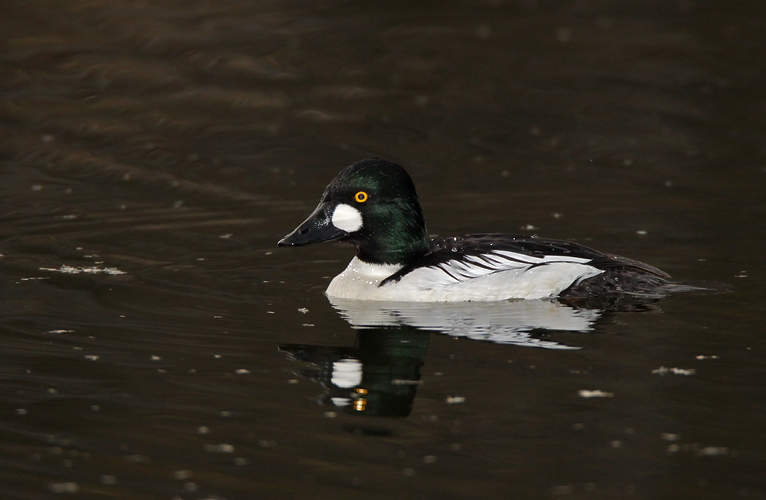
Location: Unknown
Date: 2010-01-08
Lens: Canon 600mm IS F4 + 1.4x II Converter

 Common Goldeneye
Bucephala clangula
Common Goldeneye
Bucephala clangula
 Description
Description
The eyes of the Common Goldeneye go through an interesting series of color transitions. First, the eyes start as gray-brown at hatching. Then, as the bird ages the eyes turn purple-blue, then blue, then green-blue. Eventually the eyes turn bright yellow in adult males and pale yellow to white in females.
Dives underwater to feed on aquatic invertebrates, small fish and vegetation.
General: 16 to 20 inches in size.
Adult Male ( Alternate ): Greenish/black head. Bright, golden-yellow eye. White, oval face patch at base of bill. White lower portion of neck, sides, breast, belly and secondaries. Black back, wings, and tail. Short, black bill.
Adult Male ( Basic ): Similar to female, but with some black coloring on sides.
Female: Dark brown head. Pale yellow to white eye. Slate-gray back, wings and tail. Whitish lower portion of neck, breast, flanks and belly. Short, black bill with variable length yellow tip.
Immature: Similar to female. Immature male has grayish sides and chest; also has less distinct face patch.
Primarily winters in marine waters, bays and harbors, as well as in large inland lakes and rivers. Breeds along lakes and rivers bordered by forest.
 Nesting
Nesting
5-16 glossy greenish eggs. The eggs have a 12-13? day incubation period. Fledging occurs in ? days. Nests in cavities, especially nest boxes. The cavity is lined with downy feathers from female. The female often lays eggs in the nest of another female, including that of other species, such as Barrow's Goldeneye, Wood Duck, and Hooded Mergansers.
Ducklings will often join another female's brood if abandoned or after scattering because of a territorial fight between the mother and another female. These mixed broods are called 'creches'. Some females will just abandon their young shortly after hatching. When ducklings leave the nest the mother only provides protection, as the ducklings are able to feed themselves.